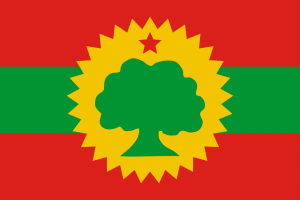Language/Borana-arsi-guji-oromo/Culture/Traditional-Music-and-Dance
| ◀️ Traditional Festivals — Previous Lesson | Next Lesson — Singular and Plural Nouns ▶️ |
Introduction[edit | edit source]
Welcome to the lesson on traditional music and dance of the Borana-Arsi-Guji Oromo people! In this lesson, we will explore the rich cultural heritage of the Oromo people and understand the significance of traditional music and dance in their lives. Music and dance play a vital role in Oromo culture, serving as a means of storytelling, celebration, and social cohesion. By the end of this lesson, you will have a deeper appreciation for the beauty and importance of Oromo music and dance.
Cultural Significance of Music and Dance[edit | edit source]
Music and dance hold a special place in the hearts of the Borana-Arsi-Guji Oromo people. They are not only forms of artistic expression but also serve as a means of preserving history, passing down traditions, and strengthening community bonds. Oromo music and dance are deeply rooted in the cultural and spiritual beliefs of the Oromo people, reflecting their values, aspirations, and experiences.
Traditional Musical Instruments[edit | edit source]
The Borana-Arsi-Guji Oromo people have a wide range of traditional musical instruments that are used to create beautiful melodies and rhythms. These instruments are often made from natural materials found in the local environment, such as wood, animal skins, and gourds. Let's explore some of the most commonly used traditional musical instruments:
| Borana-Arsi-Guji Oromo | Pronunciation | English Translation |
|---|---|---|
| "Maalimba" | [maːlɪmba] | Xylophone-like instrument |
| "Birbirsa" | [bɪrbɪrsa] | Single-stringed fiddle |
| "Gambela" | [gambɛla] | Flute |
| "Dabarro" | [dabaro] | Drum |
| "Kirar" | [kiɾaɾ] | Bowl-shaped lyre |
These instruments are not only played during festive occasions and celebrations but also during everyday activities such as farming, herding, and storytelling. They add a unique flavor to the Oromo culture and create a sense of unity and joy among the community members.
Traditional Dance Styles[edit | edit source]
Oromo traditional dance is characterized by its energetic movements, rhythmic footwork, and expressive gestures. Each dance style has its own unique steps and patterns, often accompanied by specific songs and rhythms. Let's explore some of the traditional dance styles of the Borana-Arsi-Guji Oromo people:
- "Eletta" - This dance style is characterized by quick foot movements and graceful arm gestures. It is often performed during weddings and other festive occasions.
- "Geerarsa" - Geerarsa is a popular dance style among the Oromo people, known for its circular movements and synchronized hand clapping. It is often performed during cultural festivals and social gatherings.
- "Waarso" - Waarso is a dance style that originated from the Borana region of Oromia. It involves intricate footwork, acrobatic movements, and rapid spinning. Waarso is often performed by young men to showcase their strength and agility.
Cultural Variations[edit | edit source]
It is important to note that the Oromo people are not a homogenous group, and there are regional variations in the music and dance styles across different Oromo communities. The Borana-Arsi-Guji Oromo people, for example, have their own unique musical traditions and dance styles that distinguish them from other Oromo groups. These variations reflect the diverse cultural landscape of the Oromo people and the historical influences of the different regions they inhabit.
Exercises[edit | edit source]
Now it's time to practice what you've learned! Here are some exercises to help you apply your knowledge of Borana-Arsi-Guji Oromo traditional music and dance:
1. Listen to a traditional Oromo song and try to identify the musical instruments used in the composition. Describe the overall mood and emotions conveyed by the music.
2. Watch a video of an Oromo dance performance and observe the dancers' movements and gestures. Pay attention to the footwork, hand clapping, and overall coordination. Try to imitate some of the dance steps and practice them in front of a mirror.
3. Research and write a short essay on the historical significance of Oromo music and dance in the struggle for Oromo identity and cultural preservation. Include specific examples and anecdotes to support your arguments.
Conclusion[edit | edit source]
In this lesson, we explored the cultural significance of traditional music and dance in the Borana-Arsi-Guji Oromo community. We learned about the different traditional musical instruments used by the Oromo people and the unique dance styles that are an integral part of their cultural heritage. Through music and dance, the Oromo people express their history, values, and aspirations, creating a sense of unity and pride among community members. By appreciating and participating in Oromo music and dance, we can gain a deeper understanding of their rich cultural traditions.
Other Lessons[edit | edit source]
Template:Borana-arsi-guji-oromo-Page-Bottom
| ◀️ Traditional Festivals — Previous Lesson | Next Lesson — Singular and Plural Nouns ▶️ |

